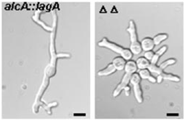Department of Chemistry
Document Type
Article
Date of this Version
3-2011
Citation
Published in Mycology 2:1 (March 2011), pp. 24–29; doi: 10.1080/21501203.2011.554907
Abstract
A large number of bioactive natural products have been isolated from plant endophytic fungi. However, molecular mechanisms for the biosynthesis of these metabolites have lagged behind because genetic and biochemical studies are difficult to perform within many of the endophytes. In this work, we describe our attempt to express a putative mycoepoxydiene (MED) biosynthetic gene cluster in Fusarium verticillioides, which has a well-developed genetic system for the study fungal polyketide biosynthesis. MED was isolated from Phomopsis sp. A123, a fungal endophyte of the mangrove plant, Kandelia candel. It has several unusual structural features and interesting biological activities. Integration of this Phomopsis gene cluster into the F. verticillioides genome led to the biosynthesis of multiple metabolites. The most highly activated metabolite was isolated and its structure was shown by 1D- and 2D-NMR to be fusaric acid, which is a mycotoxin in Fusarium species and is implicated in fungal pathogenesis. Although fusaric acid was isolated more than 70 years ago, its biosynthetic mechanism remains unclear. These transformants produced 30–35 mg fusaric acid per 100 ml culture. The high level production of fusaric acid will greatly facilitate the genetic and biochemical study of its biosynthetic mechanism. Although we have not detected MED or its analogs from the heterologous host, this work represents the first attempt to express a fungal endophytic gene cluster in a Fusarium species.



Comments
Copyright © 2011 Mycological Society of China; published by Taylor & Francis. Used by permission.